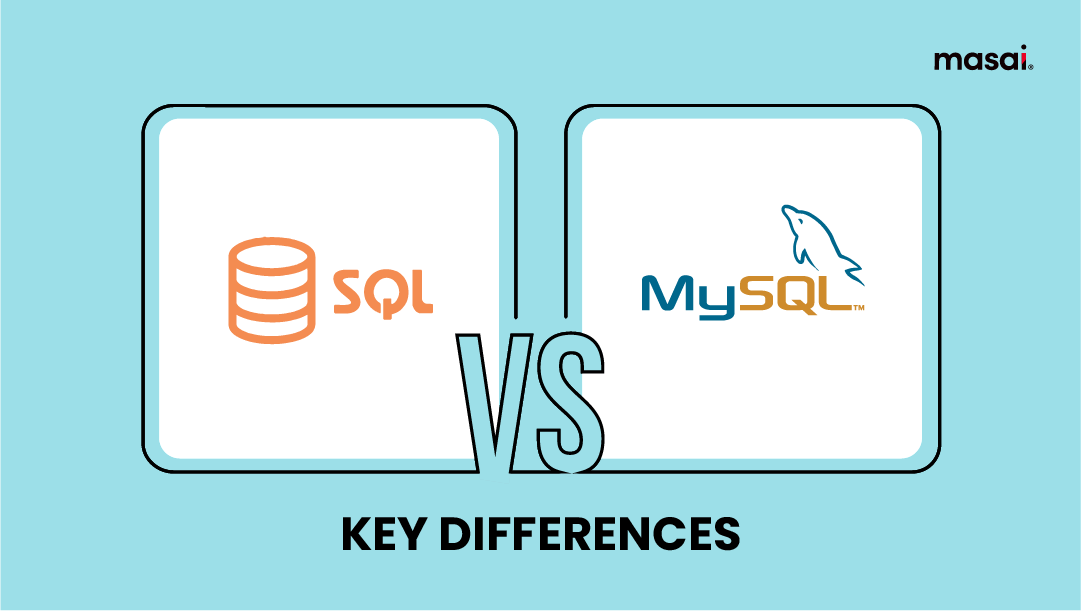SQL vs MySQL – Decoding the Differences

Uncover the differences between SQL and MySQL in this comprehensive guide. Learn how SQL is a query language, while MySQL is an open-source database management system.
SQL and MySQL are two technologies most developers are familiar with. SQL is a query language to manage and manipulate data stored in relational databases. It is a language to write commands to interact with databases. On the other hand, MySQL is a popular open-source database management system that uses SQL as its query language.
Many famous tech giants and websites, such as Facebook, Twitter, YouTube, and Wikipedia, use MySQL to manage and store their data. It is available in over 20 languages, and developers and database administrators worldwide use it to develop apps to store and manage data.
Many people have a misconception that SQL is a programming language. However, it is a query language. According to the TIOBE Index, it is currently the 5th most popular programming language worldwide as of February 2023.
As a developer, you need to have a good knowledge of these technologies, which can help you manage your data efficiently for your organization and projects. Before using the, it is essential to understand the differences between them.
This article will walk you through the detailed differences between SQL and MySQL. Before that, let us introduce you to both technologies individually.
What is SQL?
It stands for Structured Programming Language, a query language used to manage data held in relational database management systems (RDBMS). It lets us perform various tasks, such as creating tables to store data, adding, updating, and deleting data, and retrieving data from a database.
Donald Chamberlin and Raymond Boyce, two IBM researchers, developed a Structured Query Language in the 1970s after learning about Edgar F. Codd’s relational model.
A Structured Query Language is a de-facto language for relational databases. So, whether large-scale enterprise systems, dynamic web apps, or any other apps use RDBMS to store and manage data, they need SQL.
For instance, it is used in the following applications from different industry sectors:
- A bank software to manage customers' account information
- A list of PowerPoint presentations inside the software for business
- An e-commerce website to manage information about various products.
- A healthcare app to keep track of patient records.
In a nutshell, SQL is a powerful tool for working with data, and it's not too hard to learn. With a bit of practice, you can start using it to work with databases and make sense of large amounts of data.
Features
- SQL provides powerful commands for querying databases to get specific data from large sets of records. Users can use specific values, ranges, patterns, and relationships between tables to find data.
- It supports transactions, letting users do multiple things to a database simultaneously as a single atomic unit. Transactions make sure that either all of the operations are done, or none of them are executed. This helps keep data consistent.
- Users change data in databases by giving them instructions. Users can add, change, or remove records from tables with these commands.
- SQL has features like user authentication, password protection, and permission-based access that let you control who can see what data. This helps make sure that only people who are supposed to see sensitive data are able to do so. It also prevents unauthorized access and data breaches.
Applications
- Banking software and payment processors, like Stripe, manage information about customers and their financial transactions using SQL queries on their databases.
- Music apps like Spotify and Pandora also use databases to store several music tracks and albums by many singers. They use this information to find what the user is looking for, what they like, etc. And based on user preferences, they provide the output.
- Several apps like Instagram and Snapchat store a person's profile information, like their description and location. The app's databases can be updated when someone makes a new post or uploads a photo and records conversations between two people so that the user can find the contacts and read them later using SQL queries.
What is MySQL?
It is a popular open-source database management system whose primary language is SQL. It is a powerful tool for storing, organizing and retrieving large amounts of data.
In 1995, Swedish programmers Michael Widenius and David Axmark released the first version of MySQL. It was first made as a simple, lightweight alternative to other database systems. Oracle Corporation now owns MySQL and takes care of it.
This DBMS works with many data types, such as integers, decimals, strings, dates, times, and booleans. It also works with advanced data types, like BLOBs, which store images and large data files.
MySQL is known for how quickly it works and how well it handles memory. It's made to handle a lot of data and many users simultaneously, and it can be tweaked to work best with specific workloads and configurations.
Features
- It has security features, like password protection, data encryption, and SSL support, to keep your data safe.
- This DBMS can handle a lot of data and users simultaneously. It is fast, and it can quickly handle complex queries.
- It is well-known for its speed and the way it handles memory.
- It works with distributed architectures. So, you can spread your data across several servers to make them run faster and be more reliable.
Applications
- It helps store and manage data in web apps. Many popular websites and apps, like Facebook, Twitter, and WordPress, use MySQL as their main database.
- E-commerce websites and applications use it to store information about products, orders, and customers. It also powers many systems that handle payments.
- It works with business intelligence and data analytics tools to store and analyze a lot of data. The trio helps store data from the past and makes reports and dashboards, helping businesses make decisions based on data.
- Many content management systems, such as WordPress and Joomla, are using this DBMS to store and manage website content, user data, and other information.
- Many use it as a data warehouse to store and manage large amounts of data for analytics and business intelligence applications. It can also be used in conjunction with tools like Tableau and Power BI to create reports and visualizations.
SQL vs MySQL - How Do They Differ?
Best Practices for Using SQL and MySQL
When working with SQL and MySQL, following best practices is crucial to ensure efficient data management and maintain the integrity and security of your databases. Here are some key best practices to consider:
1. Database Design:
Start with a well-thought-out database schema. Properly define tables, relationships, and constraints to prevent data anomalies and ensure data accuracy.
2. Indexing:
Use indexing strategically. Index columns that are frequently used in WHERE clauses to speed up query execution. However, avoid over-indexing, as it can lead to increased storage and slower insert/update operations.
3. Normalization:
Apply database normalisation techniques to reduce redundancy and improve data integrity. This involves organising data into separate tables to minimise data duplication.
4. Data Validation:
Implement data validation at the application level to ensure that only valid and safe data is inserted into the database. This helps prevent SQL injection attacks.
5. SQL Injection Prevention:
Sanitise user inputs and use prepared statements or parameterised queries to prevent SQL injection vulnerabilities. This is essential for security.
6. Regular Backups:
Set up regular database backups to protect against data loss due to hardware failures, human errors, or other unforeseen circumstances. Test your backup and restore procedures to ensure they work correctly.
7. Optimizing Queries:
Profile and optimise SQL queries to minimise execution time and resource consumption. Tools like query analysers can help identify bottlenecks.
8. Scaling and High Availability:
Plan for scalability and high availability from the beginning. Consider strategies like database replication, load balancing, and sharding to handle increased traffic and ensure uptime.
9. Security Measures:
Enforce strong password policies and implement encryption for sensitive data. Regularly apply security updates and patches to your MySQL server.
10. Monitoring and Performance Tuning:
Use monitoring tools to track database performance and identify issues early. Adjust server configuration parameters as needed to optimise performance.
Tips for Choosing Between SQL and MySQL
Your particular project's requirements and limits will determine whether you choose MySQL as your database management system or SQL as your query language. You can use the following advice to help you decide wisely:
1. Consider Your Application Type:
Determine the nature of your application. If you need a database for a small to medium-sized project, SQL might be sufficient when combined with a lightweight database system like SQLite. MySQL's capabilities may be more appropriate for larger and more complex applications.
2. Scalability Requirements:
Assess your scalability needs. MySQL is known for its scalability and ability to handle high-traffic loads. If your application is expected to grow rapidly, MySQL's robust scalability features make it a strong choice.
3. Data Security and Compliance:
Assess your data security and compliance requirements. MySQL offers robust security features, making it suitable for applications with sensitive data. Ensure your chosen solution meets any regulatory or industry-specific compliance standards.
4. Performance Demands:
Analyse your performance requirements. If your application demands high performance and efficient data retrieval, MySQL's reputation for speed and memory handling may be advantageous.
5. Ease of Use and Learning Curve:
Evaluate your team's familiarity with SQL and MySQL. If your developers are already experienced with MySQL, it might be the most efficient choice. However, if your team is proficient in SQL and comfortable working with different database systems, you can use SQL with various RDBMS options.
Which is Better - SQL or MySQL?
Well, there is no clear winner between both technologies, as they have completely different use cases. SQL is a structured query language to store, manage and retrieve data from relational databases.
On the other hand, MySQL is a database management system, a software to create and manage databases. It uses Structured Query Language as its core language to create databases, store and retrieve data from them, and manipulate data.
Conclusion
Here we reach the end of the discussion on SQL vs MySQL. The former is a standard query language for all relational databases, while the latter is a relational database management system. There is no choice between both technologies. If you are using MySQL or any other relational database management system, you will definitely need SQL.

